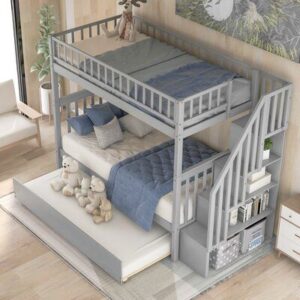No products in the basket.
Kids Stories
Are Bunk Beds Safe For Children
Introduction
If you’re a parent, chances are pretty good that you’ve thought about buying bunk beds for your kids. They’re a fun way to give multiple children their own space, and they can be used in a variety of configurations—think being able to sleep one kid on the bottom and another on top, or having one child on each side of the room. But bunk beds also come with special safety considerations because they can pose a risk of injury if not used correctly. Here’s what parents need to know about safety measures for bunk beds before they make their purchase:
Are Bunk Beds Safe
Bunk beds are safe so long as they meet the requirements of the law and are properly installed. The Consumer Product Safety Commission (CPSC) has established guidelines for bunk beds that include guardrails, ladders, and other safety features. However, these regulations aren’t always followed by manufacturers or retailers who sell bunk beds.
Even when you purchase a high-quality bunk bed that meets all safety regulations, there’s still a chance that it could be dangerous if it isn’t properly installed in your home. A poorly installed bed may cause an injury due to falling out from underneath it or from falling off one side while sleeping on top of it
The Law And Bunk Beds
Bunk beds are not regulated by law. In fact, they’re not even considered a safety issue. Bunk beds don’t fall under any specific category of consumer goods or services and so there are no laws regarding them as such.
Bunk beds do not pose any health risks to children who use them properly (i.e., following all manufacturer’s instructions). There is no evidence that sleeping on a bunk bed causes any physical harm or illness to children or adults, nor does it present any serious fire hazard risk when used correctly with proper construction materials and installation techniques for your particular model type/brand name product line sold at retail stores nationwide today!
Standard Safety Measures For Bunk Beds
Make sure the bed is stable. The frame should be stable and not wobble when you lean on it. Make sure there’s a guardrail at least five inches above the top mattress, which is required by law in most states (and if your child climbs up or down without using a ladder). You can also use an extra-tall guardrail for added protection; these are available at most stores that sell bunk beds or online through Amazon.
Make sure there’s a ladder with anti-slip rungs so that kids can get up and down safely without slipping off their feet as they climb up or down from the upper bunk–and make sure no one ever sleeps on top of the lower bunks!

Four Additional Safety Tips
- Don’t allow children to sleep on the top bunk. While it may seem like a good idea for kids to get more sleep, this can be dangerous as well. If your child falls out of bed and injures himself or herself, you could be liable for their medical bills if you don’t have insurance or if your insurance doesn’t cover it.
- Don’t allow children to climb up and down the ladder. You should also never allow your child to sit or stand on top of his/her bunk bed ladder while playing around in his room–this is just another way that injuries can occur while using these types of beds (and they’re not even being used). In addition, don’t let him/her jump off either side without supervision either!
- Make sure both sets of rails are firmly attached at all times so no one gets injured when trying desperately not fall out of bed during his nightly slumber sessions (which usually consist entirely off tossing & turning).
Shopping For The Right Bunk Bed
When buying bunk beds for kids Look for features that improve safety and comfort, such as ladders or guardrails. Choose materials that are durable and sturdy enough to last through years of use. For example, avoid beds made with particleboard or MDF board because they tend to crack easily. Instead, choose solid wood or metal frames instead–these can be more expensive but will last longer and won’t warp over time like plywood does!
Consider the size of your child’s bedroom when choosing between twin versus full/queen bunks so it doesn’t take up too much space in their room (and remember that if space isn’t an issue then go ahead and get both). Also think about whether they need space underneath where they could store some things like clothes or bookshelves etc..
Bunk Beds Can Be Safe, But They Require Special Care To Ensure Child Safety
Bunk beds can be safe, but they require special care to ensure child safety. Bunk beds are not for every family and should only be used under certain circumstances. You must take into account your child’s age, weight and height before deciding if a bunk bed is right for your family.
Bunk beds provide an affordable option for children who need extra sleeping space in their room or playroom at home. They also offer an opportunity for siblings who want to share a bedroom together but don’t have enough room in their bedroom alone. The downside is that these types of beds tend to be more dangerous than regular twin-sized mattresses because children can fall out of them if not properly secured by railings or fitted with guardrails on all sides (including underneath).
Conclusion
The most important thing to remember is that bunk beds are not toys. They’re for sleeping, playing and studying–not for climbing or jumping on. As long as you keep this in mind when shopping for a bunk bed and setting it up in your home, you should be able to ensure that your kids stay safe while having fun on their new bed!
Read More :bunk beds decorating ideas

